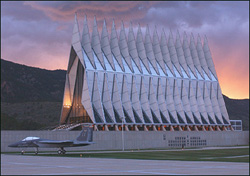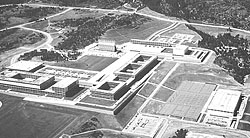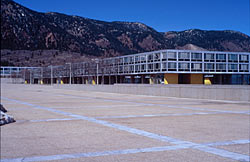
Born in the first decade of the Cold War, the United States Air Force Academy provided the new military service with a trained and educated officer corps at a time when national policy placed unprecedented emphasis on air power. Its campus, set in magnificent natural surroundings at the foot of the Rampart Range in Colorado, ranks among the finest examples of modern movement architecture commissioned by Federal agencies during the post-World War II era.
The United States reorganized its military under the National Security Act of 1947, establishing the Air Force as an independent service equal to the Army and Navy. In 1954, the Federal Government authorized the creation of the United States Air Force Academy (USAFA) to serve as the primary undergraduate educational institution of that new service, it continues to serve as an important military educational institution today. It joined the other two major U.S. academies--the United States Military Academy at West Point, New York, and the United States Naval Academy at Annapolis, Maryland--as the nation’s undergraduate military schools.

Following World War II, the United States entered into a 45-year confrontation with the Soviet Union known as the Cold War. Although it was the newest service, the Air Force emerged as the nation’s primary military arm, resulting in a major expansion of its ranks. The new service required an influx of officers, leading to the establishment of the USAFA. In the face of technological advances, including a burgeoning nuclear arsenal, the new service academy educated those officers for the increasingly complex demands of military leadership. In addition, it helped to define the Air Force's identity as distinct from the Army and Navy.
Built between 1958 and 1968, the campus was designed by Skidmore, Owings and Merrill (SOM), and broke from the traditions of West Point and Annapolis with its architectural vocabulary to become “the first U.S. national shrine to be designed in the modern style,” according to Architectural Forum magazine. Its buildings stirred a national debate in Congress, professional journals and the popular media during the early years of the Cold War. In a survey of federally-built architecture, Lois Craig declared, “Perhaps no architectural debate over government buildings in the 1950s equaled the discussion about the design of the new U.S. Air Force Academy.” The responses encapsulate many of the significant issues debated about architecture in the postwar era.

In particular, the Cadet Chapel is an exceptional example of postwar modern movement architecture. In the 1950s, while the United States engaged in the Cold War, American civil religion stood in contrast with “godless Communism.” Historian Sydney Ahlstrom remarked of the decade, “There seemed to be a consensus that personal religious faith was an essential element in proper patriotic commitment.” President Dwight Eisenhower summarized the non-sectarian attitude, stating, “Our government makes no sense unless it is founded on a deeply felt religious faith--and I don’t care what it is.” The Academy carefully embraced three major beliefs with distinct worship spaces in the chapel for Catholics, Protestants, and Jews, expanding in recent years to include Muslim, Buddhist and other faiths.
Visit the National Park Service Travel American Aviation to learn more about Aviation related Historic Sites.
Last updated: August 22, 2017
